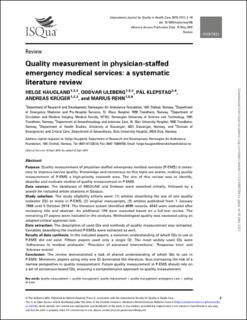Quality measurement in physician-staffed emergency medical services: a systematic literature review
Peer reviewed, Journal article
Published version
Permanent lenke
https://hdl.handle.net/11250/3042966Utgivelsesdato
2018Metadata
Vis full innførselSamlinger
Originalversjon
Haugland, H., Uleberg, O., Klepstad, P., Krüger, A., & Rehn, M. (2019). Quality measurement in physician-staffed emergency medical services: a systematic literature review. International Journal for Quality in Health Care, 31(1), 2-10. 10.1093/intqhc/mzy106Sammendrag
Purpose
Quality measurement of physician-staffed emergency medical services (P-EMS) is necessary to improve service quality. Knowledge and consensus on this topic are scarce, making quality measurement of P-EMS a high-priority research area. The aim of this review was to identify, describe and evaluate studies of quality measurement in P-EMS.
Data sources
The databases of MEDLINE and Embase were searched initially, followed by a search for included article citations in Scopus.
Study selection
The study eligibility criteria were: (1) articles describing the use of one quality indicator (QI) or more in P-EMS, (2) original manuscripts, (3) articles published from 1 January 1968 until 5 October 2016. The literature search identified 4699 records. 4543 were excluded after reviewing title and abstract. An additional 129 were excluded based on a full-text review. The remaining 27 papers were included in the analysis. Methodological quality was assessed using an adapted critical appraisal tool.
Data extraction
The description of used QIs and methods of quality measurement was extracted. Variables describing the involved P-EMSs were extracted as well.
Results of data synthesis
In the included papers, a common understanding of which QIs to use in P-EMS did not exist. Fifteen papers used only a single QI. The most widely used QIs were ‘Adherence to medical protocols’, ‘Provision of advanced interventions’, ‘Response time’ and ‘Adverse events’.
Conclusion
The review demonstrated a lack of shared understanding of which QIs to use in P-EMS. Moreover, papers using only one QI dominated the literature, thus increasing the risk of a narrow perspective in quality measurement. Future quality measurement in P-EMS should rely on a set of consensus-based QIs, ensuring a comprehensive approach to quality measurement.

